This article was submitted by members of Georgetown’s Homeless Outreach Programs and Education (HOPE), an undergraduate club focused on issues of homelessness and housing justice.
As the summer protests over the wrongful deaths of Breonna Taylor, George Floyd, and many others recede from the public view, the issues of racial injustice persist—perhaps most starkly in terms of homelessness. As of January 2020, 86.4 percent of individuals experiencing homelessness in D.C. self-identified as Black or African American. While Georgetown University claims to follow the Jesuit values of “woman and men for others,” the student body has done very little to support those most in need in our community. As such, Georgetown students are complicit in the systemic racism that permeates our society and creates the racial disparities amongst people experiencing homelessness, many of whom live less than a mile away from campus.
In a city where 47 percent of the population is Black, the Georgetown neighborhood stands out as 81 percent white and only six percent Black. However, this wasn’t always the case—Georgetown was once known as an “independent and dynamic” Black community. This changed in the 1930s, when the D.C. government stipulated excessive restoration costs to Black homeowners, causing many Black residents to be evicted from their homes in the name of historic restoration and urban redevelopment. Even if these residents could afford to return, racial restrictions in deeds prevented Black people from occupying, renting, and buying Georgetown residences. Additionally, lenders in D.C. worked to deny any credit to Black homeowners trying to move into the Georgetown community. Decades of discriminatory housing policies have turned Georgetown from a once-thriving Black community to its current state as a white enclave.
The displacement of communities of color continues in D.C. today—and Georgetown students are complicit. For example, this semester, many students decided to return independently to D.C. and live in nearby campus neighborhoods. The desire of students to return to D.C. may inadvertently make it harder for residents to live in the city and find affordable housing, further exacerbating the problem in the midst of a pandemic. As seen with the case of Duke University, when students poured into Durham looking for housing, they inadvertently worsened the city’s housing crisis by buying all of the affordable housing in the area. While D.C. is a much larger city, Georgetown students’ desire to be close to campus may cause a similar effect and bring an added disease vector to the city in a pandemic that disproportionately affects Black communities.
We, Homeless Outreach Programs and Education (HOPE), are the only student organization on campus that focuses on issues of homelessness and housing justice. In a normal semester, we distribute food, sanitation materials, and other supplies to individuals experiencing homelssness in the Georgetown and surrounding areas, but we have pivoted into a role of advocacy and education during the pandemic. As members of HOPE, we have seen firsthand how most Georgetown students interact with people experiencing homelessness and the disregard for their lives and wellbeing is abhorrent and unacceptable. Georgetown students must do better. We must recognize how our actions directly impact the lives of people experiencing homelessness and how we play a role in furthering systemic racism.
Yet, despite attending an institution with a commitment to justice and service to others in its mission statement, Georgetown students have taken minimal action to support marginal communities in the D.C. area. In the wake of mass national protesting against racial injustice, for example, many Georgetown students took to social media to join the movement. Likewise, the Dear Georgetown Instagram account, which became popular this summer, exposed several racist incidents that have transpired on our campus and served as a much-needed wake-up call to many students who believed Georgetown to be a ‘woke’ safe haven for diversity and social justice. While many campus student groups have been working to address these issues and educate others (Students for GU272+, HFIR, etc.), many students and school officials remain apathetic to these causes.
Although sharing infographics and artwork certainly has merit, there are a myriad of steps that can and should be taken by the student body to make concrete change in the community surrounding racial injustice and its consequences, from offering financial support to organizations fighting for the defunding of police to actively promoting anti-racist discussion amongst your friends and family. Performative activism is the bare minimum and only serves as a form of virtue signaling. At an institution that has access to a wealth of resources and thousands of action-oriented students, we must strive for more.
A predominantly white institution, Georgetown is home to its very own inequities in wealth and privilege. Its student body consists of relatively privileged students with the median family income being over $225,000 and 74 percent of students coming from the top 20 percent. Far too often, Georgetown students become wrapped up in the high-end shops and cobblestone streets of West Georgetown rather than confronting Georgetown’s history of racism and wealth inequality. With many of the students never facing serious financial constraints or economic disadvantages, it can be easy to take food, housing, or even clothes for granted. However, for many individuals facing poverty or experiencing homelessness, these basic needs are not guaranteed.
Georgetown students have the specific responsibility to recognize their privilege and position. As guests of D.C., we must pay more attention to Georgetown’s role in advancing gentrification and make a conscious effort to support marginalized populations within the area—including people experiencing homelessness. A substantial part of our predominantly white and wealthy community largely benefits from many of America’s inequities, and all of us have the privilege of accessing a high-quality education. Thus, Georgetown students have a duty to understand and break down the barriers that cause individuals to become unhoused.
Recently, the student body has rallied behind Georgetown’s Mutual Aid Network, which aims to reduce Georgetown’s wealth inequality by redistributing funds to students in need. This initiative shows our community can create social impact at the grassroots level. Georgetown students need to leverage their resources to advocate for those without a voice in the D.C. community. More than just signing petitions, Georgetown students have the power to influence not only their local representatives but also our vast alumni network on the Hill. Right now, our community should be pushing for D.C. to provide greater sanitation and housing resources for the homeless population. If our community truly values being an equitable, progressive neighbor in the D.C. community, we must activate our ability to create meaningful change.




